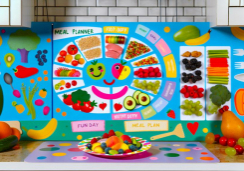3 Best Low-Carb Meal Planning Strategies for Newbies
Just as Odysseus navigated the treacherous waters of the Mediterranean, you're about to embark on your own epic journey through the world of low-carb eating. As you set sail, you'll need to arm yourself with the most effective strategies to chart a course toward a healthier lifestyle.
You'll find that the basics of carb counting are your compass, helping you to identify the hidden carbs that often go unnoticed.
When creating a balanced low-carb menu, think of it as your map to the culinary treasures that await, with an array of colorful vegetables, lean proteins, and heart-healthy fats.
And as for meal prepping, it's the anchor that keeps your diet steady amidst the busy currents of daily life.
Stick with me, and I'll guide you through the process of transforming these strategies into a seamless routine that fits into your schedule, ensuring you're well-equipped to conquer the challenges of low-carb meal planning without feeling adrift.
Understanding Carb Counting Basics
To effectively manage your low-carb diet, it's crucial to grasp the fundamentals of carb counting. This method allows you to track the carbohydrates in your meals and maintain control over your intake. Carb counting basics involve calculating the net carbs per serving of food. This is the total amount of carbohydrates minus the dietary fiber and sugar alcohols, as these aren't fully absorbed by your body.
When planning your meals, aim to know the carbohydrates per serving to help you stay within your total daily carbohydrate limit. Minimize your intake of high-carb foods and instead choose those with lower net carbs to keep your carb count in check. This approach can be effective for weight loss and managing certain medical conditions.
Consulting with a registered dietitian can provide personalized advice to determine an appropriate amount of carbohydrates for your unique needs and goals. They can guide you through the process, ensuring that you're getting the nutrients you need while keeping your carb intake at an optimal level.
Creating a Balanced Low-Carb Menu
When devising your low-carb menu, focus on incorporating a variety of fruits, vegetables, and lean proteins, complemented by select whole grains or legumes to ensure nutritional balance. A balanced low-carb diet isn't just about carbohydrate restriction; it's about choosing whole foods that provide essential nutrients.
Prioritize your protein intake to maintain muscle mass and satiety, selecting from fish, poultry, and plant-based options.
Include plenty of healthy fats from sources like avocados, nuts, and olive oil, which can help you feel full and provide energy. Don't forget fiber, which is crucial for digestive health and can be found in non-starchy vegetables and low-carb fruits like berries.
Exercise portion control to keep your daily intake in check. Visual cues like a 1/2 cup serving approximating a cupcake wrapper size can be helpful. For convenience, engage in meal prep by having low-carb-friendly foods and pre-portioned snacks ready to go.
Prepping and Storing Low-Carb Meals
Having established a balanced low-carb menu, let's explore how you can prepare and store these meals to simplify your weekly routine. As a newbie to low-carb meal planning strategies, it's vital to make your journey as convenient as possible. Prepping and storing low-carb meals effectively will help you manage your carb intake and maintain a healthy diet.
Here's what you need to do:
- Plan Your Meals: Dedicate time each week to plan and write down your meals, including breakfast, lunch, and dinner, ensuring low-carb foods to eat are always at hand.
- Invest in Containers: Purchase high-quality storage containers to keep your meals fresh and simplify grab-and-go options for your busy days.
- Batch Cooking: Cook large quantities and freeze individual portions, so you've got a variety of meals ready to eat when time is tight.
- Prep Snacks and Ingredients: Portion out snacks and prepare ingredients ahead of time to make assembling meals throughout the week a breeze.
- Label Your Meals: Always label and date your containers to track when you made your meal and to eat them while they're still fresh.
Frequently Asked Questions
How Do I Start a Low-Carb Diet for Beginners?
Start by reducing your carb intake and focusing on meal planning. Swap recipes, control portions, and find ingredient substitutes to maintain macronutrient balance. Choose smart snack options, journal your food, and shop wisely, even when dining out.
How Do You Carb Cycle for Beginners?
To start carb cycling, focus on meal timing, adjust macronutrient ratios, and plan refeed days. It'll enhance energy management, training adaptation, and metabolic flexibility, considering hormonal effects and body composition goals.
What Can You Eat the First Week of a Low-Carb Diet?
You'll focus on keto-friendly snacks, ample protein choices, and a variety of vegetables. Learn meal prep basics, portion control, and hydration importance to manage cravings and include satiating fats and sugar substitutes.
What Are the Best Tips to Follow on a Low-Carb Diet?
You'll want to master carb counting, portion control, and focus on fiber. Choose your fats wisely, prioritize protein, plan snacks, navigate eating out, stay hydrated, pick sugar alternatives, and get into meal prep.
Conclusion
Now you've got the hang of it! Keep your carb counts in check, balance your plate with fruits, veggies, and lean proteins, and choose those good fats wisely.
Remember, whole grains and legumes are your friends for essential carbs. With some smart prep and storage, you'll nail this low-carb lifestyle.
Stick with it, and you'll likely see the scale tip in your favor, your blood sugar stabilize, and your overall health blossom.
Keep it up!










